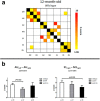Resting-state functional connectivity changes in aging apoE4 and apoE-KO mice
- PMID: 25319693
- PMCID: PMC6705289
- DOI: 10.1523/JNEUROSCI.0684-14.2014
Resting-state functional connectivity changes in aging apoE4 and apoE-KO mice
Abstract
It is well established that the cholesterol-transporter apolipoprotein ε (APOE) genotype is associated with the risk of developing neurodegenerative diseases. Recently, brain functional connectivity (FC) in apoE-ε4 carriers has been investigated by means of resting-state fMRI, showing a marked differentiation in several functional networks at different ages compared with carriers of other apoE isoforms. The causes of such hampered FC are not understood. We hypothesize that vascular function and synaptic repair processes, which are both impaired in carriers of ε4, are the major contributors to the loss of FC during aging. To test this hypothesis, we integrated several different MRI techniques with immunohistochemistry and investigated FC changes in relation with perfusion, diffusion, and synaptic density in apoE4 and apoE-knock-out (KO) mice at 12 (adult) and 18 months of age. Compared with wild-type mice, we detected FC deficits in both adult and old apoE4 and apoE-KO mice. In apoE4 mice, these changes occurred concomitant with increased mean diffusivity in the hippocampus, whereas perfusion deficits appear only later in life, together with reduced postsynaptic density levels. Instead, in apoE-KO mice FC deficits were mirrored by strongly reduced brain perfusion since adulthood. In conclusion, we provide new evidence for a relation between apoE and brain connectivity, possibly mediated by vascular risk factors and by the efficiency of APOE as synaptic modulator in the brain. Our results show that multimodal MR neuroimaging is an excellent tool to assess brain function and to investigate early neuropathology and aging effects in translational research.
Keywords: apoE; apoE4 mice; cerebral blood flow; diffusion tensor imaging; functional connectivity; resting-state fMRI.
Copyright © 2014 the authors 0270-6474/14/3413963-13$15.00/0.
Figures








Similar articles
-
A Dietary Treatment Improves Cerebral Blood Flow and Brain Connectivity in Aging apoE4 Mice.Neural Plast. 2016;2016:6846721. doi: 10.1155/2016/6846721. Epub 2016 Mar 10. Neural Plast. 2016. PMID: 27034849 Free PMC article.
-
Reducing human apolipoprotein E levels attenuates age-dependent Aβ accumulation in mutant human amyloid precursor protein transgenic mice.J Neurosci. 2012 Apr 4;32(14):4803-11. doi: 10.1523/JNEUROSCI.0033-12.2012. J Neurosci. 2012. PMID: 22492035 Free PMC article.
-
Behavioral phenotyping of GFAP-apoE3 and -apoE4 transgenic mice: apoE4 mice show profound working memory impairments in the absence of Alzheimer's-like neuropathology.Exp Neurol. 2001 Aug;170(2):326-44. doi: 10.1006/exnr.2001.7715. Exp Neurol. 2001. PMID: 11476599
-
APOE-related biomarker profiles in non-pathological aging and early phases of Alzheimer's disease.Neurosci Biobehav Rev. 2013 Sep;37(8):1322-35. doi: 10.1016/j.neubiorev.2013.05.006. Epub 2013 May 20. Neurosci Biobehav Rev. 2013. PMID: 23701948 Review.
-
Apolipoprotein E isoforms in Alzheimer's disease pathology and etiology.Microsc Res Tech. 2000 Aug 15;50(4):278-81. doi: 10.1002/1097-0029(20000815)50:4<278::AID-JEMT5>3.0.CO;2-T. Microsc Res Tech. 2000. PMID: 10936880 Review.
Cited by
-
Structural-functional connectivity deficits of neocortical circuits in the Fmr1 (-/y) mouse model of autism.Sci Adv. 2015 Nov 20;1(10):e1500775. doi: 10.1126/sciadv.1500775. eCollection 2015 Nov. Sci Adv. 2015. PMID: 26702437 Free PMC article.
-
Therapeutic effects of the mitochondrial ROS-redox modulator KH176 in a mammalian model of Leigh Disease.Sci Rep. 2017 Sep 15;7(1):11733. doi: 10.1038/s41598-017-09417-5. Sci Rep. 2017. PMID: 28916769 Free PMC article.
-
Alternation of Resting-State Functional Connectivity Between Visual Cortex and Hypothalamus in Guinea Pigs With Experimental Glucocorticoid Enhanced Myopia After the Treatment of Electroacupuncture.Front Neuroinform. 2021 Jan 13;14:579769. doi: 10.3389/fninf.2020.579769. eCollection 2020. Front Neuroinform. 2021. PMID: 33519409 Free PMC article.
-
Angiotensin II, hypertension and angiotensin II receptor antagonism: Roles in the behavioural and brain pathology of a mouse model of Alzheimer's disease.J Cereb Blood Flow Metab. 2017 Jul;37(7):2396-2413. doi: 10.1177/0271678X16667364. Epub 2016 Jan 1. J Cereb Blood Flow Metab. 2017. PMID: 27596834 Free PMC article.
-
Common functional networks in the mouse brain revealed by multi-centre resting-state fMRI analysis.Neuroimage. 2020 Jan 15;205:116278. doi: 10.1016/j.neuroimage.2019.116278. Epub 2019 Oct 12. Neuroimage. 2020. PMID: 31614221 Free PMC article.
References
Publication types
MeSH terms
Substances
LinkOut - more resources
Full Text Sources
Other Literature Sources
Medical
Molecular Biology Databases
Research Materials
Miscellaneous
